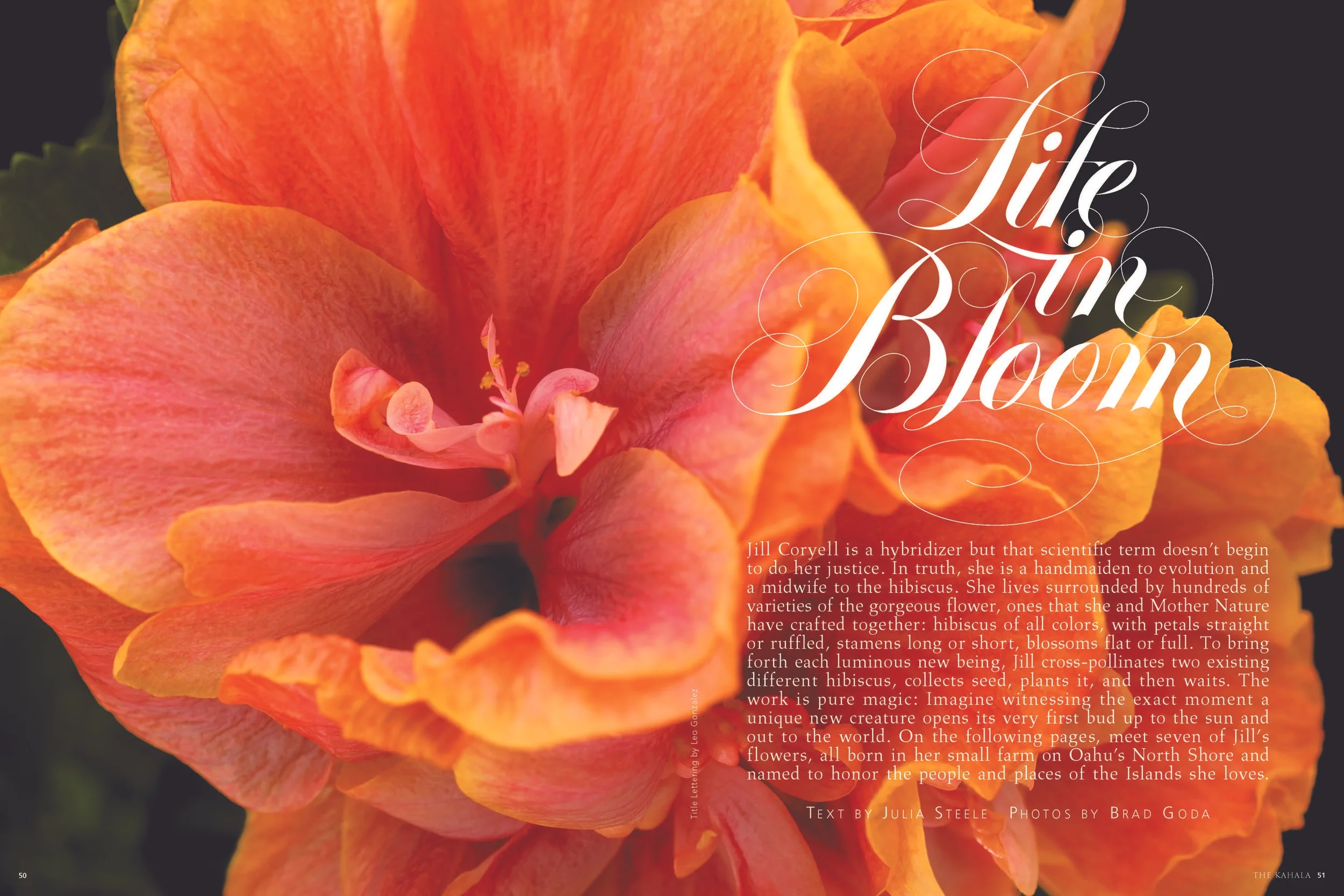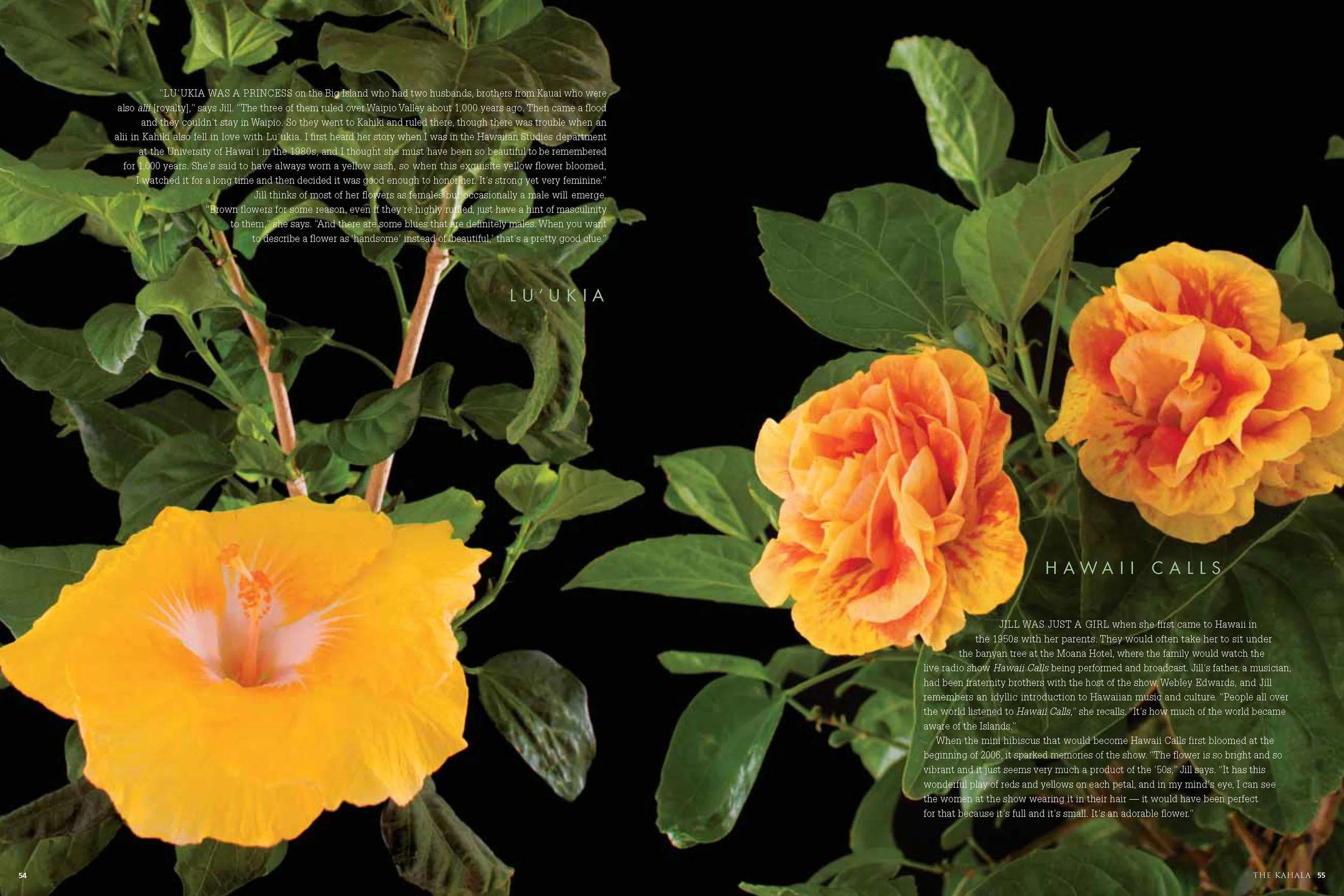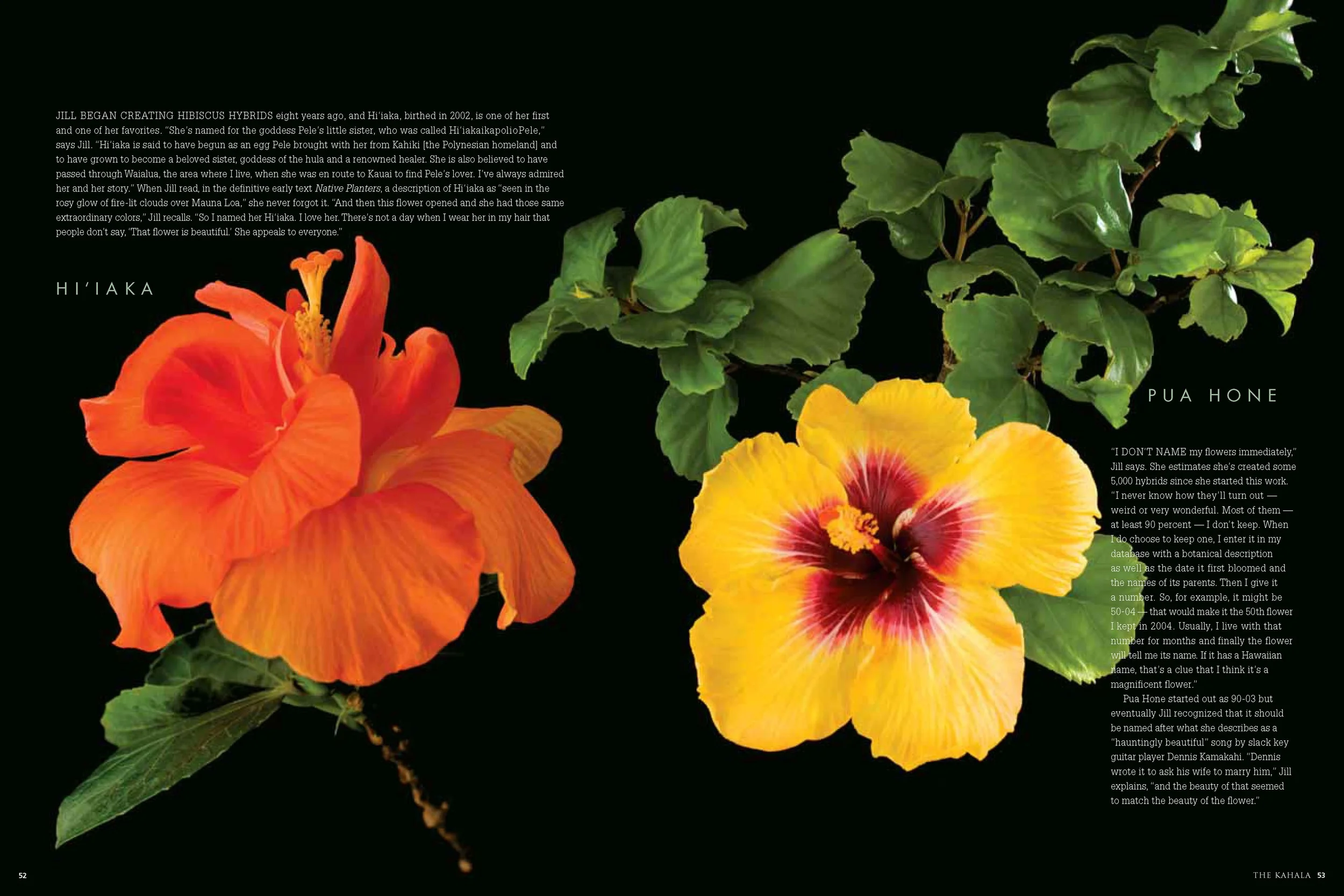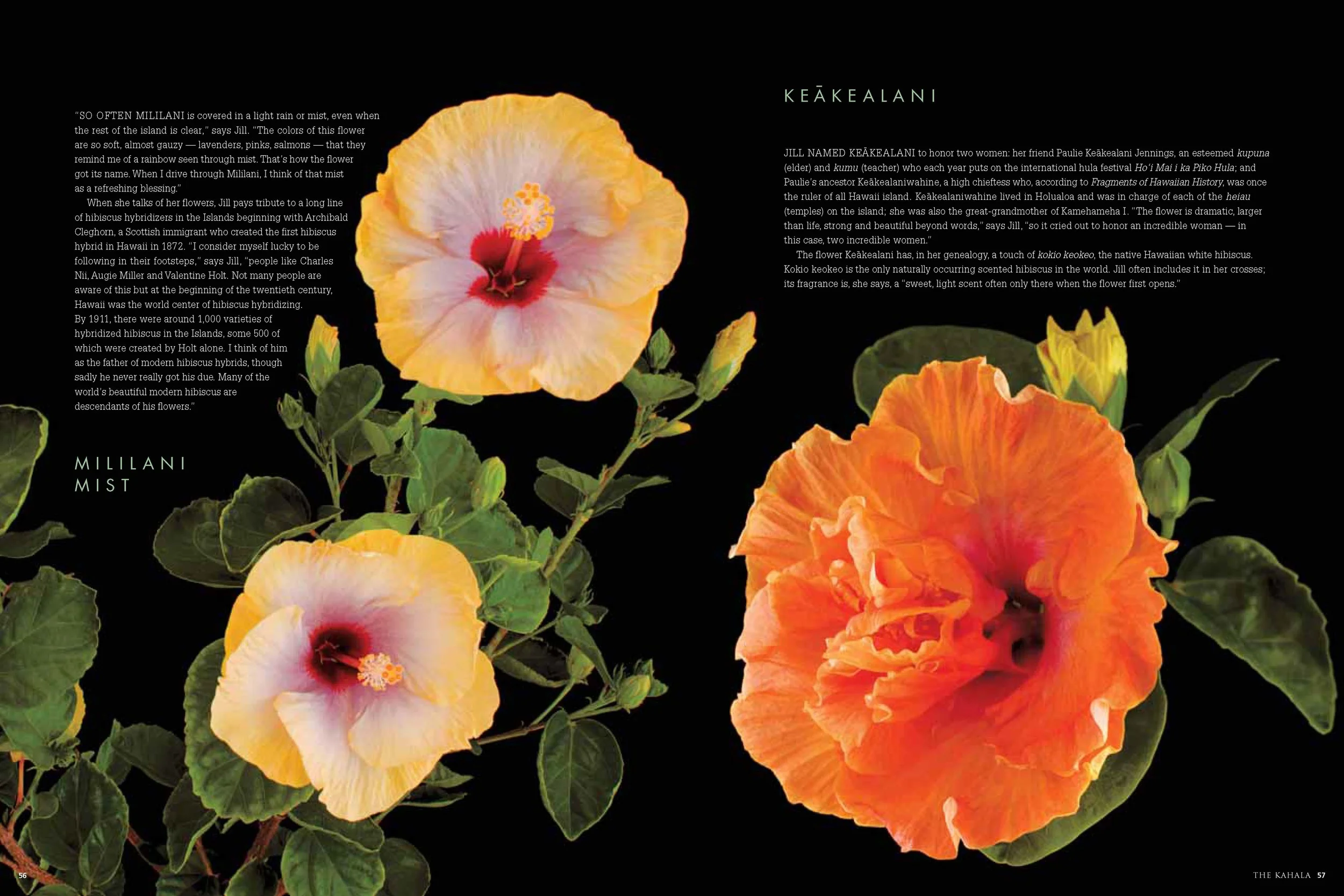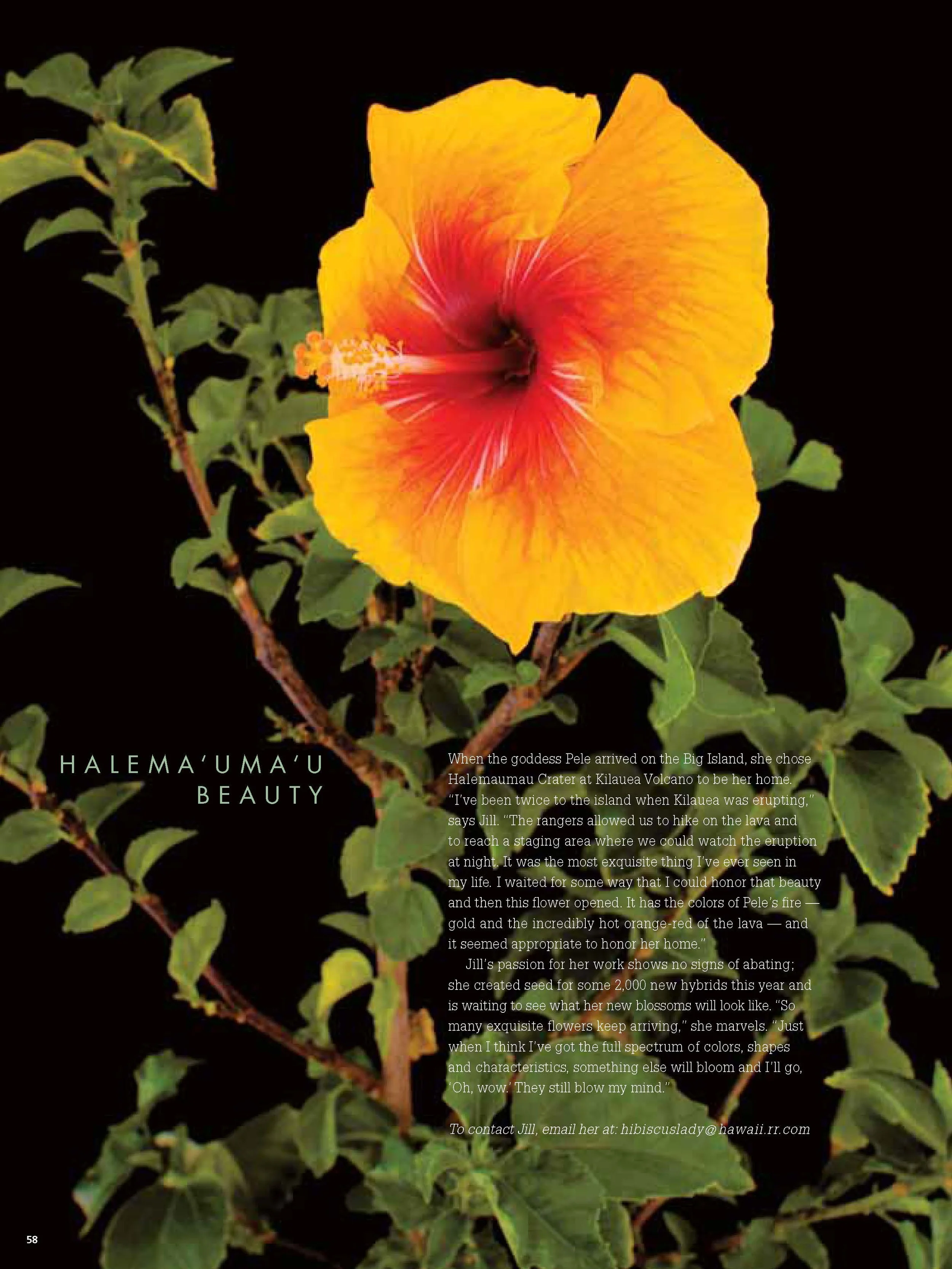Jill Coryell is a hybridizer but that scientific term doesn’t begin to do her justice. In truth, she is a handmaiden to evolution and a midwife to the hibiscus. She lives surrounded by hundreds of varieties of the gorgeous flower, ones that she and Mother Nature have crafted together: hibiscus of all colors, with petals straight or ruffled, stamens long or short, blossoms flat or full. To bring forth each luminous new being, Jill cross-pollinates two existing different hibiscus, collects seed, plants it, and then waits. The work is pure magic: Imagine witnessing the exact moment a unique new creature opens its very first bud up to the sun and out to the world. On the following pages, meet seven of Jill’s flowers, all born in her small farm on O‘ahu’s North Shore and named to honor the people and places of the Islands she loves.
Hi‘iaka: Jill began creating hibiscus hybrids eight years ago, and Hi‘iaka, birthed in 2002, is one of her first and one of her favorites. “She’s named for the goddess Pele’s little sister, who was called Hi‘iakaikapolioPele,” says Jill. “Hi‘iaka is said to have begun as an egg Pele brought with her from Kahiki [the Polynesian homeland] and to have grown to become a beloved sister, goddess of the hula and a renowned healer. She is also believed to have passed through Waialua, the area where I live, when she was en route to Kauai to find Pele’s lover. I’ve always admired her and her story.” When Jill read, in the definitive early text Native Planters, a description of Hi‘iaka as “seen in the rosy glow of fire-lit clouds over Mauna Loa,” she never forgot it. “And then this flower opened and she had those same extraordinary colors,” Jill recalls. “So I named her Hi‘iaka. I love her. There’s not a day when I wear her in my hair that people don’t say, ‘That flower is beautiful.’ She appeals to everyone.”
Pua Hone: “I don’t name my flowers immediately,” Jill says. She estimates she’s created some 5,000 hybrids since she started this work. “I never know how they’ll turn out — weird or very wonderful. Most of them — at least 90 percent — I don’t keep. When I do choose to keep one, I enter it in my database with a botanical description as well as the date it first bloomed and the names of its parents. Then I give it a number. So, for example, it might be 50-04 — that would make it the 50th flower I kept in 2004 . Usually, I live with that number for months and finally the flower will tell me its name. If it has a Hawaiian name, that’s a clue that I think it’s a magnificent flower.” Pua Hone started out as 90-03 but eventually Jill recognized that it should be named after what she describes as a “hauntingly beautiful” song by slack key guitar player Dennis Kamakahi. “Dennis wrote it to ask his wife to marry him,” Jill explains, “and the beauty of that seemed to match the beauty of the flower.”
Lu‘ukia: Lu‘ukia was a princess on the Big Island who had two husbands, brothers from Kauai who were also ali‘i [royalty],” says Jill. “The three of them ruled over Waipio Valley about 1,000 years ago. Then came a flood and they couldn’t stay in Waipio. So they went to Kahiki and ruled there, though there was trouble when an ali‘i in Kahiki also fell in love with Lu‘ukia. I first heard her story when I was in the Hawaiian Studies department at the University of Hawai‘i in the 1980s, and I thought she must have been so beautiful to be remembered for 1,000 years. She’s said to have always worn a yellow sash, so when this exquisite yellow flower bloomed, I watched it for a long time and then decided it was good enough to honor her. It’s strong yet very feminine.” Jill thinks of most of her flowers as females but occasionally a male will emerge. “Brown flowers for some reason, even if they’re highly ruffled, just have a hint of masculinity to them,” she says. “And there are some blues that are definitely males. When you want to describe a flower as ‘handsome’ instead of ‘beautiful,’ that’s a pretty good clue.”
Hawai‘i Calls: Jill was just a girl when she first came to Hawai‘i in the 1950s with her parents. They would often take her to sit under the banyan tree at the Moana Hotel, where the family would watch the live radio show Hawaii Calls being performed and broadcast. Jill’s father, a musician, had been fraternity brothers with the host of the show, Webley Edwards, and Jill remembers an idyllic introduction to Hawaiian music and culture. “People all over the world listened to Hawaii Calls,” she recalls. “It’s how much of the world became aware of the Islands.” When the mini hibiscus that would become Hawai‘i Calls first bloomed at the beginning of 2006, it sparked memories of the show. “The flower is so bright and so vibrant and it just seems very much a product of the ’50s,” Jill says. “It has this wonderful play of reds and yellows on each petal, and in my mind’s eye, I can see the women at the show wearing it in their hair — it would have been perfect for that because it’s full and it’s small. It’s an adorable flower.”
Mililani Mist: “So often Mililani is covered in a light rain or mist, even when the rest of the island is clear,” says Jill. “The colors of this flower are so soft, almost gauzy — lavenders, pinks, salmons — that they remind me of a rainbow seen through mist. That’s how the flower got its name. When I drive through Mililani, I think of that mist as a refreshing blessing.” When she talks of her flowers, Jill pays tribute to a long line of hibiscus hybridizers in the Islands beginning with Archibald Cleghorn, a Scottish immigrant who created the first hibiscus hybrid in Hawaii in 1872. “I consider myself lucky to be following in their footsteps,” says Jill, “people like Charles Nii, Augie Miller and Valentine Holt. Not many people are aware of this but at the beginning of the twentieth century, Hawai‘i was the world center of hibiscus hybridizing. By 1911, there were around 1,000 varieties of hybridized hibiscus in the Islands, some 500 of which were created by Holt alone. I think of him as the father of modern hibiscus hybrids, though sadly he never really got his due. Many of the world’s beautiful modern hibiscus are descendants of his flowers.”
Keakealani: Jill named Keakealani to honor two women: her friend Paulie Keakealani Jennings, an esteemed kupuna (elder) and kumu (teacher) who each year puts on the international hula festival Ho‘i Mai i ka Piko Hula; and Paulie’s ancestor Keakealaniwahine, a high chieftess who, according to Fragments of Hawaiian History, was once the ruler of all Hawaii island. Keakealaniwahine lived in Holualoa and was in charge of each of the heiau (temples) on the island; she was also the great-grandmother of Kamehameha I . “The flower is dramatic, larger than life, strong and beautiful beyond words,” says Jill, “so it cried out to honor an incredible woman — in this case, two incredible women.” The flower Keakealani has, in her genealogy, a touch of kokio keokeo, the native Hawaiian white hibiscus. Kokio keokeo is the only naturally occurring scented hibiscus in the world. Jill often includes it in her crosses; its fragrance is, she says, a “sweet, light scent often only there when the flower first opens.”
Halema‘uma‘u Beauty: When the goddess Pele arrived on the Big Island, she chose Halema‘uma‘u Crater at Kilauea Volcano to be her home. “I’ve been twice to the island when Kilauea was erupting,” says Jill. “The rangers allowed us to hike on the lava and to reach a staging area where we could watch the eruption at night. It was the most exquisite thing I’ve ever seen in my life. I waited for some way that I could honor that beauty and then this flower opened. It has the colors of Pele’s fire — gold and the incredibly hot orange-red of the lava — and it seemed appropriate to honor her home.” Jill’s passion for her work shows no signs of abating; she created seed for some 2,000 new hybrids this year and is waiting to see what her new blossoms will look like. “So many exquisite flowers keep arriving,” she marvels. “Just when I think I’ve got the full spectrum of colors, shapes and characteristics, something else will bloom and I’ll go, ‘Oh, wow.’ They still blow my mind.”
